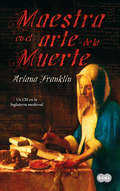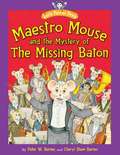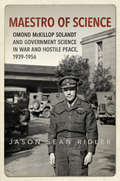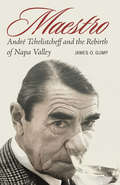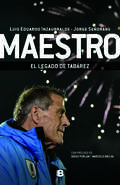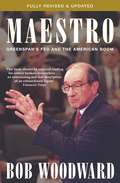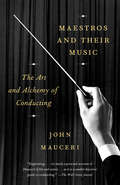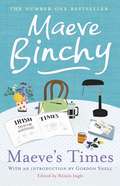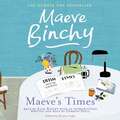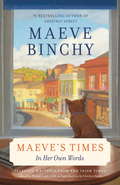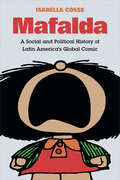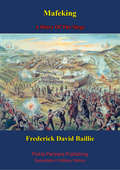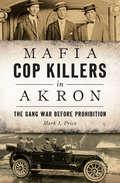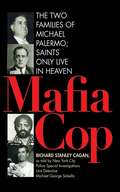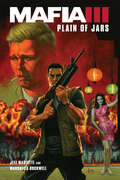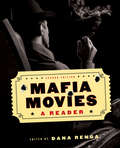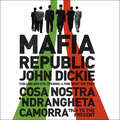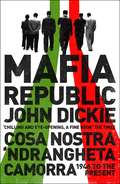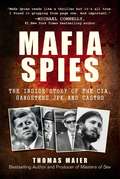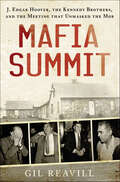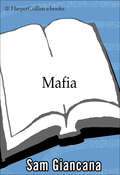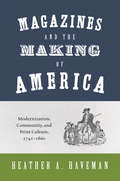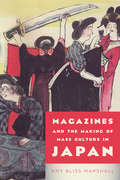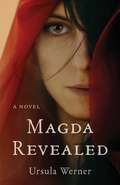- Table View
- List View
Maestra en el arte de la muerte
by Ariana FranklinUn CSI en la Inglaterra medieval... Inglaterra, año del Señor de 1171: en Cambridge aparece el cadáver de un niño horriblemente asesinado. Otros muchos han desaparecido. Los judíos, directamente acusados de estos crímenes por la todopoderosa jerarquía católica, buscan refugio entre los muros del castillo para evitar las iras de los soliviantados ciudadanos. Al rey Enrique esta situación dista de complacerle: necesita a los judíos para llenar sus arcas y debe encontrarse al verdadero culpable para aplacar al pueblo, que ha elevado a la categoría de santo al niño asesinado. Para esclarecer la situación aparecen en Cambridge un reputado doctor, Simón de Nápoles, acompañado de una misteriosa mujer de origen árabe, Adelia Aguilar, y de un enigmático hombre, Mansur. La especialidad de Adelia, doctora en la célebre escuela de medicina de Salerno, es el estudio y la disección de cadáveres. Se trata de una maestra en el arte de la muerte, algo que debe disimular cuidadosamente si no quiere correr el riesgo de ser acusada de brujería. Las investigaciones conducen a Adelia hasta el último rincón de Cambridge. Encontrará amigos que la ayudarán y hallará el amor... pero también tendrá que luchar denodadamente con un terrible asesino dispuesto a seguir matando y con las supersticiones y prejuicios de los habitantes de la ciudad.
Maestro Mouse: And the Mystery of the Missing Baton
by Cheryl S. Barnes Peter W. BarnesMaestro Mouse, the world's greatest conductor, makes an unfortunate discovery when he takes the stage to lead his orchestra-his baton is missing! The children in the concert hall rush to search for it in section of the orchestra, learning about each instrument as they go along. Will they find the lost baton in time for the concert to begin?
Maestro of Science
by Jason S. RidlerOne of the brightest Canadian scientists of his generation, Omond McKillop Solandt was a physiologist by training, an engineer by disposition, and a manager by necessity. A protégé of insulin's co-discoverer, Charles Best, Solandt worked as a scientist for the British government during the Second World War, including as a pioneer of operational research and a manager of scientific establishments. Ending the war as a colonel, he served on the British Mission to Japan, where he studied the effects of the atomic bombs at Hiroshima and Nagasaki, before returning to Canada to become chairman of the newly created Defence Research Board. There he spearheaded Canada's attempt to create a new and innovative government science infrastructure that served the needs of the Canadian military at the dawn of the nuclear age and worked alongside allies in Britain and the United States.In Maestro of Science, Jason S. Ridler draws on interviews with Solandt and his colleagues and declassified records from Canada and the United Kingdom to paint a vivid picture of the influence and achievements of a Canadian leader in Cold War military research.
Maestro: André Tchelistcheff and the Rebirth of Napa Valley (At Table)
by James O. GumpWine insiders called André Tchelistcheff the &“winemaker&’s winemaker,&” the &“wine doctor,&” and simply &“maestro.&” After Prohibition brought Napa Valley and its wine industry to the brink of catastrophe, Tchelistcheff (1901–94) proved essential in its revitalization. Tchelistcheff&’s unique background—a sickly child, a Russian émigré forced from his homeland during the Bolshevik Revolution, a White Army lieutenant who fought in the Crimea, a physical laborer in a Bulgarian coal mine, a Czechoslovakian-trained agronomist, and a French-schooled viticulturist and enologist—prepared him for a remarkable winemaking career. He spent thirty-five years in Napa Valley&’s Beaulieu Vineyard and nearly two &“post-retirement&” decades doing freelance consulting work for more than thirty wineries. His early struggles forged his principal character traits, which he passed on to an entire generation of winemakers. His students, including some of the most accomplished winemakers of the post-Prohibition period, marveled over their mentor&’s sense of authority, profound insight, humble presence, and abundant wisdom. This inspiring account of Tchelistcheff&’s life includes interviews with friends, family, and mentees, which reveal how one man used his passion and knowledge to help save a community on the edge of disaster. In Maestro James O. Gump preserves the memory of a fascinating individual and one of the most influential winemakers of the modern era.
Maestro: El legado de Tabárez
by Jorge Señorans Luis InzaurraldeEl papel del Maestro Tabárez, las historias íntimas y desconocidas del proceso de la selección uruguaya contado por sus protagonistas. Una mirada a la Selección por dentro, en la voz de sus protagonistas. Su intimidad, su costado humano y los aspectos desconocidos de un proceso que provocó una revolución e impulsó su refundación hasta conseguir recuperar la esencia más pura de la Celeste, dentro y fuera del campo de juego. Una historia de trabajo en silencio, de sacrificio y de esfuerzo. De planificar y esperar. De creer; de apostar a largo plazo y confiar en jugadores para una época. De aprender a sufrir para poder disfrutar. De encontrar la recompensa en el camino recorrido y de profundizar en las raíces de los procesos juveniles para cambiar el futuro. Una historia en la que la suerte también jugó de su lado, y que los éxitos se transformaron en aliados inquebrantables para construir fortalezas. Aquel proyecto que durante años dio vueltas en la cabeza de Tabárez, esperando una segunda oportunidad, desembarcó en la sede de la calle Guayabos el 6 de marzo de 2006 para volver a encauzar a Uruguay hacia su lugar. Transcurrieron doce años de compromiso con un modelo. Doce años que promovieron la transformación más profunda en la historia de la Selección a partir del rumbo que estableció un entrenador y que todos fueron asumiendo como propio hasta transformar en orgullo de un pueblo. Doce años de respeto que permitieron recuperar la confianza, reconstruir la mística y reinventar la fórmula de la Selección. Doce años derribando mitos. Doce años que se transformaron en el legado de Tabárez, que hoy queda como referencia para el futuro, porque así lo hicieron los uruguayos. A su manera.
Maestro: Greenspan's Fed and the American Boom
by Bob WoodwardIn eight Tuesdays each year, Federal Reserve chairman Alan Greenspan convenes a small committee to set the short-term interest rate that can move through the American and world economies like an electric jolt. As much as any, the committee's actions determine the economic well-being of every American. The availability of money for business or consumer loans, mortgages, job creation and overall national economic growth flows from those decisions. Perhaps the last Washington secret is how the Federal Reserve and its enigmatic chairman, Alan Greenspan, operate. In Maestro, Bob Woodward takes you inside the Fed and Greenspan's thinking. We listen to the Fed's internal debates as the American economy is pushed into a historic 10-year expansion while the world economy lurches from financial crisis to financial crisis. Greenspan plays a sometimes subtle, sometimes blunt behind-the-scenes role. He appears in Maestro up close as never before -- alternately nervous and calm, plunging into mathematics one moment and politics the next, skeptical, dispassionate, always struggling -- often alone. Maestro traces a fascinating intellectual journey as Greenspan, an old-school anti-inflation hawk of the traditional economy, is among the first to realize the potential in the modern, high-productivity new economy -- the foundation of the current American boom. Woodward's account of the Greenspan years is a remarkable portrait of a man who has become the symbol of American economic preeminence.
Maestros and Their Music: The Art And Alchemy Of Conducting
by John MauceriAn exuberant, uniquely accessible, beautifully illustrated look inside the enigmatic art and craft of conducting, from a celebrated conductor whose international career has spanned half a century. John Mauceri brings a lifetime of experience to bear in an unprecedented, hugely informative, consistently entertaining exploration of his profession, rich with anecdotes from decades of working alongside the greatest names of the music world. With candor and humor, Mauceri makes clear that conducting is itself a composition: of legacy and tradition, techniques handed down from master to apprentice--and more than a trace of ineffable magic. He reveals how conductors approach a piece of music (a calculated combination of personal interpretation, imagination, and insight into the composer's intent); what it takes to communicate solely through gesture, with sometimes hundreds of performers at once; and the occasionally glamorous, often challenging life of the itinerant maestro. Mauceri, who worked closely with Leonard Bernstein for eighteen years, studied with Leopold Stokowski, and was on the faculty of Yale University for fifteen years, is the perfect guide to the allure and theater, passion and drudgery, rivalries and relationships of the conducting life.
Maeve's Times
by Maeve Binchy'Maeve's Times is funny and clever and kind, which are excellent qualities in both books and people' Irish Times'As someone who fell off a chair not long ago trying to hear what they were saying at the next table in a restaurant, I suppose I am obsessively interested in what some might consider the trivia of other people's lives.'Maeve Binchy is well known for her bestselling novels, but for many years Maeve was a journalist. From 'The Student Train' to 'Plane Bores' and 'Bathroom Joggers' to 'When Beckett met Binchy', these articles have all the warmth, wit and humanity of her fiction. Arranged in decades, from the 1960s to the 2000s, and including Maeve's first and last ever piece of writing for the Irish Times, the columns also give a fascinating insight into the author herself.With an introduction written by her husband, the writer Gordon Snell, this collection of timeless writing reminds us of why the leading Irish writer was so universally loved.
Maeve's Times
by Maeve Binchy'Maeve's Times is funny and clever and kind, which are excellent qualities in both books and people' Irish Times'As someone who fell off a chair not long ago trying to hear what they were saying at the next table in a restaurant, I suppose I am obsessively interested in what some might consider the trivia of other people's lives.'Maeve Binchy is well known for her bestselling novels, but for many years Maeve was a journalist. From 'The Student Train' to 'Plane Bores' and 'Bathroom Joggers' to 'When Beckett met Binchy', these articles have all the warmth, wit and humanity of her fiction. Arranged in decades, from the 1960s to the 2000s, and including Maeve's first and last ever piece of writing for the Irish Times, the columns also give a fascinating insight into the author herself.With an introduction written by her husband, the writer Gordon Snell, this collection of timeless writing reminds us of why the leading Irish writer was so universally loved.
Maeve's Times
by Maeve BinchyAs someone who fell off a chair not long ago trying to hear what they were saying at the next table in a restaurant, I suppose I am obsessively interested in what some might consider the trivia of other people's lives.'Maeve Binchy is well-known for her bestselling novels, the most recent of which was A WEEK IN WINTER. But for many years Maeve was a journalist, writing for the IRISH TIMES. From 'The Student Train' to 'Plane Bores' and 'Bathroom Joggers' to 'When Beckett met Binchy', these articles have all the warmth, wit and humanity of her fiction. Arranged in decades, from the 1960s to the 2000s, and including Maeve's first and last ever piece of writing for the IRISH TIMES, the columns also give a fascinating insight into the author herself.With an introduction written by her husband, the writer Gordon Snell, this collection of timeless writing reminds us of why the leading Irish writer was so universally loved.Read by Kate Binchy(p) 2013 Orion Publishing Group
Maeve's Times: In Her Own Words
by Maeve BinchyFive decades of selected writings from the Irish Times by the beloved and best-selling author, filled with her hallmark humor, candor, and wisdom-a timeless gift to her legion of fans.Maeve Binchy once confessed: "As someone who fell off a chair not long ago trying to hear what they were saying at the next table in a restaurant, I suppose I am obsessively interested in what some might consider the trivia of other people's lives." She was an accidental journalist, yet from the beginning, her writings reflected the warmth, wit, and keen human interest that readers would come to love in her fiction. From the royal wedding to boring airplane companions, Samuel Beckett to Margaret Thatcher, "senior moments" to life as a waitress, Maeve's Times gives us wonderful insight into a changing Ireland as it celebrates the work of one of our best-loved writers in all its diversity-revealing her characteristic directness, laugh-out-loud humor, and unswerving gaze into the true heart of a matter.
Mafalda: A Social and Political History of Latin America's Global Comic (Latin America in Translation)
by Isabella CosseSince its creation in 1964, readers from all over the world have loved the comic Mafalda, primarily because of the sharp wit and rebellious nature of its title character—a four-year-old girl who is wise beyond her years. Through Mafalda, Argentine cartoonist Joaquín Salvador Lavado explores complex questions about class identity, modernization, and state violence. In Mafalda: A Social and Political History of Latin America's Global Comic—first published in Argentina in 2014 and appearing here in English for the first time—Isabella Cosse analyzes the comic's vast appeal across multiple generations. From Mafalda breaking the fourth wall to speak directly to readers to express her opposition to the 1966 Argentine coup, to Spanish students' protest signs bearing her face, to the comic's cult status in Korea, Cosse provides insights into the cartoon's production, circulation, and incorporation into social and political conversations. Analyzing how Mafalda reflects generational conflicts, gender, modernization, the Cold War, authoritarianism, neoliberalism, and much more, Cosse demonstrates the unexpected power of humor to shape revolution and resistance.
Mafeking: A Diary Of The Siege [Illustrated Edition]
by Frederick David BaillieThe siege of Mafeking still stands as one of the British Military's high achievements, especially during the depths of the badly handled Boer War. The successful defence and relief were a shot in the arm for the British public which had become all too used to defeats and reverses in South Africa. Leading the heroic defence of Mafeking was the Colonel Baden-Powell, whose ingenious new methods of keeping the defence going - such as an armoured train, a salvaged cannon, fake barbed wire - were to become part of his legend.Enduring the siege with Baden-Powell was the correspondent for the Morning Chronicle, F.D Baillie, a late major in the 4th Queen's Own Hussars; who wrote a day-by-day account of the siege from behind the defences.This edition benefits from numerous illustrations from the newspaper clippings of the time.
Mafia Cop Killers in Akron: The Gang War before Prohibition (True Crime)
by Mark J. PriceFrom 1917 to 1919, terror struck the streets of Akron. As soldiers marched off to World War I and Spanish influenza ravaged the community, police officers faced a sinister threat. Murderous kingpin Rosario Borgia placed a bounty on officers' heads for interfering with his criminal enterprises. Gangsters gunned down seven cops, killing five, in a series of brazen attacks over fifteen months. Author Mark J. Price chronicles the crimes, victims, gangsters and the relentless pursuit of justice.
Mafia Cop: The Two Families of Michael Palermo; Saints Only Live in Heaven
by Richard CaganDetective Michael Palermo built his career on his unique ability to inhabit two worlds at once: the world of law enforcement and the underworld of New York’s crime family organizations. Palermo participated in over two thousand arrests while maintaining close relationships with the kingpins of organized crime—ties that allowed him to stay one step ahead of the rest of the New York City Police Department. This true crime drama takes you inside the police force at its most corrupt and into the dark and dirty world of dons, consiglieres, underbosses, button men, soldiers, and cowboys.
Mafia III: Plain of Jars (Mafia III)
by Jeff Mariotte Marsheila RockwellA mobster’s adopted son sees action in the Vietnam War and as a CIA operative in this pulp-fiction-inspired prequel to the hit video game.Before Lincoln Clay laid waste to New Bordeaux in his quest for vengeance against the Italian mob, he did an equally action-packed tour of Vietnam. In this authorized prequel to the hit game Mafia III, Clay learns the skills he will use back in New Bordeaux—first as an Army grunt, then as a Special Forces soldier running covert ops for the CIA.Featuring characters and locations from the game and a brand-new, original storyline full of intrigue, passion, and suspense, Mafia III: Plain of Jars is a great read for fans of the game and crime genre hounds looking for more of the Mafia world to explore.
Mafia Movies: A Reader, Second Edition (Toronto Italian Studies)
The mafia has always fascinated filmmakers and television producers. Al Capone, Salvatore Giuliano, Lucky Luciano, Ciro Di Marzio, Roberto Saviano, Don Vito and Michael Corleone, and Tony Soprano are some of the historical and fictional figures that contribute to the myth of the Italian and Italian-American mafias perpetuated onscreen. This collection looks at mafia movies and television over time and across cultures, from the early classics to the Godfather trilogy and contemporary Italian films and television series. The only comprehensive collection of its type, Mafia Movies treats over fifty films and TV shows created since 1906, while introducing Italian and Italian-American mafia history and culture. The second edition includes new original essays on essential films and TV shows that have emerged since the publication of the first edition, such as Boardwalk Empire and Mob Wives, as well as a new roundtable section on Italy’s “other” mafias in film and television, written as a collaborative essay by more than ten scholars. The edition also introduces a new section called “Double Takes” that elaborates on some of the most popular mafia films and TV shows (e.g. The Godfather and The Sopranos) organized around themes such as adaptation, gender and politics, urban spaces, and performance and stardom.
Mafia Republic: Italy's Criminal Curse. Cosa Nostra, 'Ndrangheta and Camorra from 1946 to the Present
by John DickieThe author of the bestselling COSA NOSTRA and MAFIA BROTHERHOODS explores the terrifying consequences of the rise of the Italian mafias.In MAFIA REPUBLIC, John Dickie, Professor of Italian Studies at University College, London and author of the international bestsellers COSA NOSTRA and MAFIA BROTHERHOODS, shows how the Italian mafias have grown in power and become more and more interconnected, with terrifying consequences. In 1946, Italy became a democratic Republic, thereby entering the family of modern western nations. But deep within Italy there lurked a forgotten curse: three major criminal brotherhoods, whose methods had been honed over a century of experience. As Italy grew, so did the mafias. Sicily's Cosa Nostra, the camorra from Naples, and the mysterious 'ndrangheta from Calabria stood ready to enter the wealthiest and bloodiest period of their long history.Italy made itself rich by making scooters, cars and handbags. The mafias carved out their own route to wealth through tobacco smuggling, construction, kidnapping and narcotics. And as criminal business grew exponentially, the mafias grew not just more powerful, but became more interconnected.By the 1980s, Southern Italy was on the edge of becoming a narco-state. The scene was set for a titanic confrontation between heroic representatives of the law, and mafiosi who could no longer tolerate any obstacle to their ambitions. This was a war for Italy's future as a civilized country. At its peak in 1992-93, the 'ndrangheta was beheading people in the street, and the Sicilian mafia murdered its greatest enemies, investigating magistrates Giovanni Falcone and Paolo Borsellino, before embarking on a major terrorist bombing campaign on the Italian mainland.Today, the long shadow of mafia history still hangs over a nation wracked by debt, political paralysis, and widespread corruption. While police put their lives on the line every day, one of Silvio Berlusconi's ministers said that Italy had to 'learn to live with the mafia'; suspicions of mafia involvement still surround some of the country's most powerful media moguls and politicians. The latest investigations show that its reach is astonishing: it controls much of Europe's wholesale cocaine trade, and representatives from as far away as Germany, Canada and Australia come to Calabria to seek authorisation for their affairs. Just when it thought it had finally contained the mafia threat, Italy is now discovering that it harbours the most global criminal network of them all.The Financial Times described John Dickie's MAFIA BROTHERHOODS as 'Powered by the sort of muscular prose that one associates with great detective fiction' and in MAFIA REPUBLIC John Dickie again marries outstanding scholarship with compelling storytelling.(P) 2020 Hodder & Stoughton Ltd
Mafia Republic: Italy's Criminal Curse. Cosa Nostra, 'ndrangheta And Camorra From 1946 To The Present
by John DickieIn MAFIA REPUBLIC, John Dickie, Professor of Italian Studies at University College, London and author of the international bestsellers COSA NOSTRA and MAFIA BROTHERHOODS, shows how the Italian mafias have grown in power and become more and more interconnected, with terrifying consequences. In 1946, Italy became a democratic Republic, thereby entering the family of modern western nations. But deep within Italy there lurked a forgotten curse: three major criminal brotherhoods, whose methods had been honed over a century of experience. As Italy grew, so did the mafias. Sicily's Cosa Nostra, the camorra from Naples, and the mysterious 'ndrangheta from Calabria stood ready to enter the wealthiest and bloodiest period of their long history.Italy made itself rich by making scooters, cars and handbags. The mafias carved out their own route to wealth through tobacco smuggling, construction, kidnapping and narcotics. And as criminal business grew exponentially, the mafias grew not just more powerful, but became more interconnected.By the 1980s, Southern Italy was on the edge of becoming a narco-state. The scene was set for a titanic confrontation between heroic representatives of the law, and mafiosi who could no longer tolerate any obstacle to their ambitions. This was a war for Italy's future as a civilized country. At its peak in 1992-93, the 'ndrangheta was beheading people in the street, and the Sicilian mafia murdered its greatest enemies, investigating magistrates Giovanni Falcone and Paolo Borsellino, before embarking on a major terrorist bombing campaign on the Italian mainland.Today, the long shadow of mafia history still hangs over a nation wracked by debt, political paralysis, and widespread corruption. While police put their lives on the line every day, one of Silvio Berlusconi's ministers said that Italy had to 'learn to live with the mafia'; suspicions of mafia involvement still surround some of the country's most powerful media moguls and politicians. The latest investigations show that its reach is astonishing: it controls much of Europe's wholesale cocaine trade, and representatives from as far away as Germany, Canada and Australia come to Calabria to seek authorisation for their affairs. Just when it thought it had finally contained the mafia threat, Italy is now discovering that it harbours the most global criminal network of them all.
Mafia Spies: The Inside Story of the CIA, Gangsters, JFK, and Castro
by Thomas MaierFrom the Bestselling Author and Television Producer of MASTERS OF SEX, a True Story of Espionage and Mobsters, Based on the Never-Before-Released JFK Files, and Optioned by Warner Bros.Mafia Spies is the definitive account of America’s most remarkable espionage plots ever—with CIA agents, mob hitmen, “kompromat” sex, presidential indiscretion, and James Bond-like killing devices together in a top-secret mystery full of surprise twists and deadly intrigue. In the early 1960s, two top gangsters, Johnny Roselli and Sam Giancana, were hired by the CIA to kill Cuba’s Communist leader, Fidel Castro, only to wind up murdered themselves amidst Congressional hearings and a national debate about the JFK assassination. Mafia Spies revolves around the outlaw friendship of these two mob buddies and their fascinating world of CIA spies, fellow Mafioso in Chicago, Cuban exile commandos in Miami, beautiful Hollywood women, famous entertainers like Frank Sinatra’s Rat Pack in Las Vegas, Castro’s own spies in Havana and his double agents hidden in Florida, J. Edgar Hoover’s FBI snooping, and the Kennedy administration’s “Get Castro” obsession in Washington. Thomas Maier is among the first to take full advantage of the National Archives’ 2017–18 release of the long-suppressed JFK files, many of which deal with the CIA’s top secret anti-Castro operation in Florida and Cuba. With several new investigative findings, Mafia Spies is a spy exposé, murder mystery, and shocking true story that recounts America’s first foray into the assassination business, a tale with profound impact for today’s Trump era. Who killed Johnny and Sam—and why wasn’t Castro assassinated despite the CIA’s many clandestine efforts?
Mafia Summit: J. Edgar Hoover, the Kennedy Brothers, and the Meeting That Unmasked the Mob
by Gil ReavillThe true story of how a small-town lawman in upstate New York busted a Cosa Nostra conference in 1957, exposing the Mafia to America.In a small village in upstate New York, mob bosses from all over the country—Vito Genovese, Carlo Gambino, Joe Bonanno, Joe Profaci, Cuba boss Santo Trafficante, and future Gambino boss Paul Castellano—were nabbed by Sergeant Edgar D. Croswell as they gathered to sort out a bloody war of succession.For years, FBI director J. Edgar Hoover had adamantly denied the existence of the Mafia, but young Robert Kennedy immediately recognized the shattering importance of the Apalachin summit. As attorney general when his brother JFK became president, Bobby embarked on a campaign to break the spine of the mob, engaging in a furious turf battle with the powerful Hoover.Detailing mob killings, the early days of the heroin trade, and the crusade to loosen the hold of organized crime, this momentous story will captivate fans of Gus Russo and Luc Sante. Reavill scintillatingly recounts the beginning of the end for the Mafia in America and how it began with a good man in the right place at the right time.“The best, and best-written, true-crime story I’ve ever read. It’s as suspenseful, detailed, racy, and knowing as a novel by Hammett or Chandler.” —Howard Frank Mosher, award-winning author of North Country“A close investigation into the crime bosses’ upstate New York summit and its grisly aftermath, Reavill’s book accurately recreates one of the golden eras of American organized crime.” —Publishers Weekly
Mafia: The Government's Secret File on Organized Crime
by Sam Giancana“A treasure trove for true crime buffs and mob aficionados—the mug shots alone are worth the price of admission.” —Nicholas Pileggi, #1 New York Times–bestselling author of WiseguyForeword by Sam GiancanaSome time in the early 1960s, during the golden age of organized crime in America—the era that would inspire The Godfather, Goodfellas, and even The Sopranos—federal investigators pulled every known piece of information on more than 800 Mafia members worldwide into a thick, phone-book-sized directory. From old-school gangsters like Lucky Luciano and Mickey Cohen to young turks like Paul Castellano and Vinny “The Chin” Gigante, the guide offered at-a-glance profiles of small-time thugs and major dons alike . . . and was allegedly the book Attorney General Robert F. Kennedy used to investigate the mob.Recently discovered, and published for the first time in this facsimile edition, Mafia is a treasure trove of info on the underworld in mid-century America—a revelatory artifact and an irresistible read.“Fascinating . . . A panoramic view of the American underworld—the national face seen in a fun house mirror.” —The New York Times Book Review“For mobheads and true crime fanatics, [Mafia] is the equivalent of a hijacked truck of unmarked bills. It’s also a quirky little slice of the American dream.” —Salon.com “Make room on your true-crime bookshelf for this veritable high school yearbook of America’s criminal class.” —T. J. English, New York Times–bestselling author of Born to Kill“Mafia is the Bible for Mafia-watchers and amateur detectives everywhere.” —Legs McNeil, coauthor of Please Kill Me
Magazines and the Making of America: Modernization, Community, and Print Culture, 1741-1860
by Heather A. HavemanFrom the colonial era to the onset of the Civil War, Magazines and the Making of America looks at how magazines and the individuals, organizations, and circumstances they connected ushered America into the modern age. How did a magazine industry emerge in the United States, where there were once only amateur authors, clumsy technologies for production and distribution, and sparse reader demand? What legitimated magazines as they competed with other media, such as newspapers, books, and letters? And what role did magazines play in the integration or division of American society? From their first appearance in 1741, magazines brought together like-minded people, wherever they were located and whatever interests they shared. As America became socially differentiated, magazines engaged and empowered diverse communities of faith, purpose, and practice. Religious groups could distinguish themselves from others and demarcate their identities. Social-reform movements could energize activists across the country to push for change. People in specialized occupations could meet and learn from one another to improve their practices. Magazines built translocal communities--collections of people with common interests who were geographically dispersed and could not easily meet face-to-face. By supporting communities that crossed various axes of social structure, magazines also fostered pluralistic integration.Looking at the important role that magazines had in mediating and sustaining critical debates and diverse groups of people, Magazines and the Making of America considers how these print publications helped construct a distinctly American society.
Magazines and the Making of Mass Culture in Japan (Studies in Book and Print Culture)
by Amy Bliss MarshallMagazines & the Making of Mass Culture in Japan provides a detailed yet approachable analysis of the mechanisms central to the birth of mass culture in Japan by tracing the creation, production, and circulation of two critically important family magazines, Kingu (King) and Ie no hikari (Light of the Home). These magazines served to embed new instruments of mass communication and socialization within Japanese society and created mechanisms to facilitate the dissemination of hegemonic forms of discourse in Japan in the first half of the twentieth century. The amazing success of Kingu and Ie no hikari during the 1920s and 1930s not only established and normalized participation in a Japanese mass national audience - a community which had previously not existed - but also facilitated the rise of Japanese mass consumer culture in the postwar years. Amy Bliss Marshall argues that the postwar mass Japanese national consumer is foreshadowed by the mass national audience created by family magazines of the interwar era. This book analytically narrates the creation and development of such publications, one explicitly capitalist and one outwardly agrarian, based on missions with an overarching desire to create a mass Japanese magazine audience. Magazines & the Making of Mass Culture in Japan highlights the importance of the seemingly innocuous acts of mass, leisure consumption of magazines and the goods advertised therein, thus aiding our understanding of the creation and direction of a new form of social participation and understanding - an essential part of not only the culture but also the politics of the transwar period.
Magda Revealed
by Ursula WernerWhat would Jesus do? This wry, irreverent, fictionalized account of his life and ministry—told from the perspective of disciple Mary Magdalene—will implode everything you thought you knew.Jesus Christ—Yeshua, to his friends—is not happy. Two thousand years after his death, he sees Earth heading toward oblivion. Ever eager to save humanity, he asks Mary Magdalene (Magda) for help. It&’s time to tell the real story of our time together, he says. Time to correct all the misinformation, misogyny, and lies spread by Peter, Paul, and the Roman Catholic Church. Still pissed that she&’s been called a whore for almost two millennia, Magda resists—but ultimately, out of love for Yeshua, reluctantly agrees. Through Magda&’s words, Yeshua—to most today a symbolic, practically mythological Biblical figure—comes back to life as a man of flesh and blood, one wholly devoted to spreading his message of radical equality. Magda tells of her travels with Yeshua and his followers around Galilee, where they are menaced at every turn by Roman rulers. She relates tales of miracles and murder, jealousy and acceptance, misogyny and female empowerment. She describes her relationship with Yeshua, clarifying centuries of speculation about whether or not they were in love. And, painfully, she reveals the truth about who orchestrated his death. But Magda&’s narrative does not end there. Her life with Yeshua has taught her that she has more strength than she ever imagined, and she begins to tap into a spiritual power that is uniquely her own—the power to connect people. Magda&’s true role in the history of humanity, it turns out, is just beginning to unfold.
